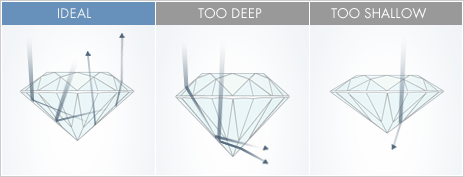WHAT MAKES A DIAMOND SPARKLE
Brilliance is an essential attribute of a beautiful diamond and has 2 components; brightness and contrast. Bright diamonds return lots of light from the surroundings back up through the crown to a 'face up' observer. If light from above leaks out the back of a diamond, naturally it has less brightness. But light that enters and leaves in the face up direction is wasted because your head blocks the lights. Diamonds that are too deep or very shallow do this -they have areas that act like a mirror back to the viewer; they return less light and so they have less brightness.
To be brilliant, a diamond needs more than just brightness. Consider the contrast of a chess board, although it has only 1/2 the light return of a sheet of white paper, it appears brighter, especially when it is moved because it 'scintillates'.
Fire or dispersed light appears as flashes of rainbow colors. You see more fire in darker environments like restaurants that have just a few point light sources or just a flickering candle. Fire is also a result of a diamond's symmetry and proportions. There are several factors that greatly influence the amount of fire a diamond produces such as star facet length, lower girdle facet length, pavilion angle, facet junctions, the angle at which light enters the diamond, and the angle of the light rays as they exit the diamond.
Diamond experts have known for a long time that steep crown angles and small tables (like 'old cut' diamonds) produce more fire. But this combination also produces less light return. Less light return makes it easier to see fiery flashes that might otherwise be swamped by bright white sparkles; this is one reason is why old cut diamonds and some fancy cuts appear to have a lot of fire.
Scintillation is the intense sparkles in a diamond as it moves. Black and white sparkles of scintillation show well in flood lit or office lighting environments where fire can be totally absent. Under pin point or spot lights fire also adds to scintillation. Ideally a diamond has many pleasing flashes spread across the surface of the stone, with few dull dead patches.
Polish is graded the same way as symmetry: Ideal, Excellent, Very Good, Good, Fair or Poor on a GIA report. Poorly polished facets may reduce the intensity of light reflected from, or refracted into and out of, a diamond. Labs assess polish by examining the diamond, facet by facet, with reflected light under a microscope; you or I may not see any difference.
How symmetry and proportions maximize light return
Every facet in an Ideal Cut diamond must be placed at precise angles and contain precise proportions. This ensures an Ideal balance between maximum brilliance and dispersion of light. Any discrepancy from these proportions will disrupt the even distribution and dispersion of light within the stone, resulting in a loss of sparkle.

A well-proportioned pavilion is especially important to a diamond's brilliance. Brilliance is the brightness created by the combination of all the white light reflections from the surface and the inside of a polished diamond. If the pavilion is too deep or too shallow, it causes light to strike outside the critical angle - the largest angle at which light rays inside the diamond can escape - causing the light to exit through the pavilion rather than reflecting back to the eye as brilliance.
Were your questions answered? Click here to contact us today.






